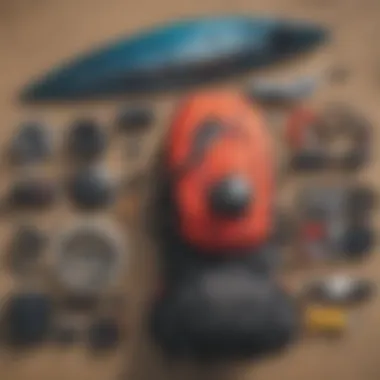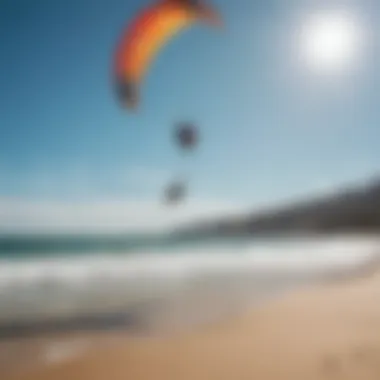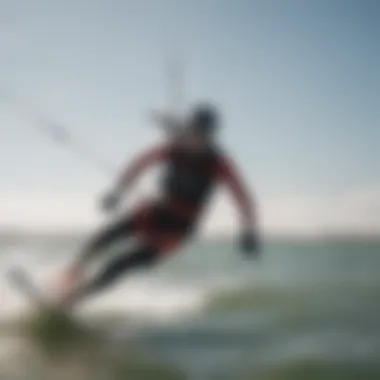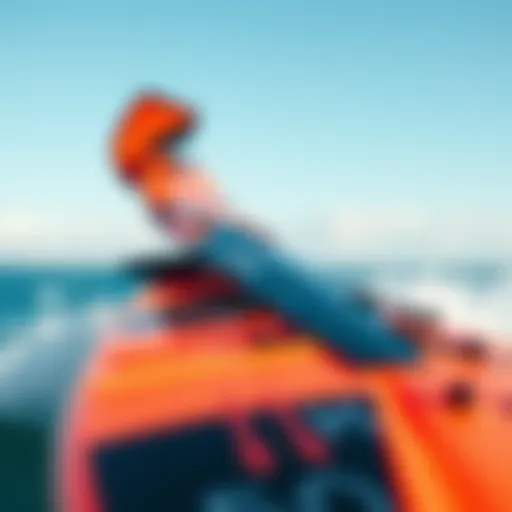Discovering the Basics of Kiteboarding Rides


Intro
Kiteboarding is as exhilarating as it is challenging. It merges the thrill of surfing with the finesse of flying a kite, all while you dance on water. For those who are stepping into this vibrant sport, the idea of a simple ride can feel both inviting and daunting. It’s not just about the adrenaline rush; it’s about understanding the nuances that make up this entire experience. A simple ride can illuminate a path leading to more adventurous escapades on the water.
Before sailing off into the sunset, let’s examine the foundational elements that create this exhilarating experience. This article will provide insight into essential gear, introduce crucial techniques for smoother rides, and highlight safety measures crucial for every new kiteboarder. We’ll even touch on where to kiteboard and the community that thrives around the sport. Each segment offers a glimpse into how these aspects interact to cultivate an enjoyable kiteboarding journey, even for the novice.
Gear Insights
Choosing the right gear can make or break your experience in kiteboarding, especially for beginners. Finding equipment tailored to your skill level can give you the security to explore the waves without stressing over malfunctions or mishaps.
Latest Gear Reviews
There’s a flurry of options available, each promising to deliver an epic ride. However, not all gear is created equal. Recent advancements have peppered the market with innovative products. Take the Duotone Evo kite, known for its versatile design, allowing both newcomers and experts to experience a smooth ride. Another notable mention is the Slingshot Rocket Wing, perfect for those who lean toward surf-style riding. Having the right kite, board, and harness isn’t just about brand; it's about matching these elements with your unique riding style.
Essential Gear for Beginners
For those just launching into this sport, the essentials can be summarized as:
- Kite: Aim for a medium-sized kite, roughly 7-12 meters, depending on wind conditions.
- Board: A freestyle board that’s wider can stabilize your ride, making transitions easier.
- Harness: Ensure it’s comfortable and fits well; this is your direct connection to the kite's pull.
- Safety gear: Helmets and impact vests can help reduce injuries in case of sudden dips.
Having equipment that gives you some confidence on the water is key. It's like having a well-tuned vehicle before embarking on a road trip; it drastically reduces worries.
Techniques and Tips
Once your gear is sorted, it’s time to nail down riding techniques. The process might seem straightforward, but there are plenty of finer details that can make a significant difference.
Advanced Tricks and Techniques
As you grow more comfortable on the water, mastering techniques like edging and pop transitions can elevate your experience. Edging helps control your speed and direction, while transitioning from heel-to-toe side will open up a world of possibilities as you refine your skills!
Safety Practices for Kiteboarders
No ride is worth risking your safety. Always keep a watchful eye on the weather and wind directions before heading out. Kiteboarding is exhilarating but also comes with risks. Wear a helmet, and let others know your expected route and plans.
"Safety isn’t just a rule; it’s a mindset to embrace before catching any waves."
Understanding the area you'll be kiteboarding in is equally crucial. Local tide patterns, currents, and wind conditions can dramatically affect your experience. Whether it’s the beaches of Tarifa in Spain or the bays of Hood River in Oregon, being informed can mean the difference between a remarkable outing and a troublesome one.
Epilogue
The journey into kiteboarding is one of exploration. Embracing the simplicity of a first ride lays the groundwork for future adventures. Equip yourself, hone your techniques, and respect the water and winds. With every venture on your board, you’re not just riding; you’re becoming a part of a vibrant community that thrives on freedom and adrenaline. So whether it's just you and the ocean or you're sharing the waves with fellow enthusiasts, the excitement of a simple ride awaits.
Understanding the Essence of a Simple Ride
Grasping the essence of a simple ride in kiteboarding is crucial, especially for beginners looking to take their first steps into this exhilarating sport. When kiteboarders talk about a simple ride, they usually refer to a grasp of the fundamental aspects that make the experience enjoyable and accessible. Getting this right can be a game-changer for anyone starting on the water.
To understand a simple ride fully, one must appreciate the balance between skills and enjoyment. The goal isn't just to stand on the board and fly down the water but to feel a connection to the kite, the wind, and the ocean. This connection transforms the ride from a mere activity into an experience where learners can focus on their form and control without overwhelming components.
Defining a Simple Ride
A simple ride can be thought of as the fundamental experience of kiteboarding, where a rider harnesses the kite's power while maintaining balance and control on the board. It's all about feeling the wind in your face and the water beneath your feet. Typically, this involves basic techniques such as the proper stance, using the kite for traction, and keeping calm on the water.
For many walkers on the beach turning into riders in the water, a simple ride promotes comfort. This experience is often characterized by minimal interruptions or disturbances, allowing for a focus on personal improvement rather than complicated tricks or showmanship. So, as each pull of the kite draws the rider along the coastline, they gradually learn how the kite behaves and how it influences their path.
The Appeal of Simplicity in Kiteboarding
There’s a refreshing charm in simplicity, especially in kiteboarding. The appeal lies in its straightforward nature, offering beginners an entry point that feels manageable yet exciting. When riders, especially novices, experience that first easy ride, they might liken it to riding a bicycle for the first time. It’s about learning to trust your instincts while engaging with nature in a relaxing way.
Moreover, simplicity in kiteboarding allows for a greater appreciation of one’s surroundings. As riders glide across calm waters, they can witness the beauty of sunsets or feel the thrill as gusts pick up without the distraction of complex maneuvers. Embracing a straightforward approach helps break down the intimidating aspects, making the sport more inviting.
In essence, the simplicity of a ride not just imparts fundamental skills but nurtures passion and curiosity. It encourages experimentation with one's pace and style and fosters a love for the sport. This is particularly important in a community-oriented sport like kiteboarding, where sharing moments on the water becomes an invaluable aspect of the experience. As an added bonus, fostering this simplicity can help build confidence among newcomers — launching their journey into kiteboarding with gusto.
The beauty of kiteboarding lies in its simplicity, which opens great possibilities for both learning and enjoyment.
Understanding these key components allows beginners to appreciate not only the ride itself but also the journey of growth and learning that kiteboarding offers.
Key Equipment for Novice Riders
When stepping into the exhilarating world of kiteboarding, having the right equipment plays a crucial role in enhancing the overall experience. For beginners, understanding the importance of gear not only contributes to safety but also fosters confidence on the water. It can be tempting to dive in headfirst with whatever seems shiny, but a thoughtful approach to learning the ropes can make all the difference. This section will unravel the essentials that every novice rider should consider, setting the groundwork for that simple ride that encapsulates the spirit of this sport.
Essential Kiteboarding Gear
Kiteboarding is both an art and a science, and the tools of the trade are entrusted with a hefty responsibility. The right equipment can dramatically boost performance, ease the learning curve, and yes—make those early sessions less daunting. In particular, there are three main components worth diving into: kites, boards, and harnesses.
Kites


The heart of kiteboarding lies in the kite. A beginner’s first kite can shape their journey and influence how quickly they pick up the sport. Generally, beginners lean toward flexible kites designed for easier handling. These kites feature a moderate aspect ratio, were plenty of power without being too aggressive.
This type of kite is a popular choice among novices because it provides a forgiving ride. The unique feature here is the depower capability, which allows riders to reduce lift and power when feeling a bit overwhelmed. It’s like having an invisible safety net that protects you from the wind letting loose.
However, not all kites are created equal. Some designs can be problematic for beginners. A kite with an overly steep wind range may lead to excessive lift and unwanted tumbles as you get used to maneuvering it, so that’s crucial to keep in mind.
Boards
Then, we have the board. The board is your connection to the water, and selecting the right one can pivot the transition from land to sea. A wider board is generally more stable, making it a friendly option for individuals just starting. Most novice riders gravitate toward a directional board for its natural inclination to glide smoothly through waves.
The standout feature of these boards is their surface area. A larger surface area means better buoyancy, which helps prevent a rider from sinking when they first hit the water. This aspect alone makes it easier to get up and ride for the first time. On the flip side, this can also lead to slower maneuvering, so patience will be your ally as you learn.
Harnesses
Finally, we arrive at harnesses—often an overlooked piece of the puzzle but undeniably significant. They serve as the critical link between the rider and the kite. For novices, a harness that distributes the load evenly across the body can prevent fatigue and discomfort. A seat harness or waist harness can be a matter of preference, but both types have unique advantages that can enhance the overall experience.
A seat harness, for instance, tends to stay in place more effectively for beginners, offering support around the hips for a more stable feel. Meanwhile, a waist harness allows for greater freedom of movement. The key is to find a harness that feels snug yet comfortable, as a well-fitted harness can enhance control and responsiveness without cramping your style.
Selecting the Right Gear for Beginners
So, how does one go about choosing the right gear? This isn’t merely a matter of aesthetics; it’s about matching your gear to your riding style and local conditions. Factors such as wind speed, water type, and even your body weight should play a significant role in your decision-making process.
Pay attention when purchasing gear; local shops often have knowledgeable staff who can guide you. Plus, consider asking fellow kiteboarders for recommendations. Community insights can often lead you to gear that fits both your skill level and your advenurous spirit.
"Invest in quality gear as a solid foundation. It's worth its weight in ensuring a safer and more enjoyable kiteboarding experience."
From this discussion, it’s clear that while the thrill of kiteboarding beckons, the right equipment is key to setting a solid foundation. Once you have the essentials, it's time to focus on the techniques and the joy of riding—elements that can take your simple ride to soaring heights.
Techniques for an Effortless Ride
The techniques employed in kiteboarding directly inform not only the enjoyment of the sport but also the safety and effectiveness of each ride. Mastering these techniques elevates a kiteboarder's experience from mere survival on the water to a graceful dance with the elements. An effortless ride hinges on three core techniques: body positioning and balance, steering and control of the kite, and utilizing wind conditions effectively. Understanding these elements allows riders to navigate, adapt, and fully enjoy their time on the water, transforming even the most basic rides into memorable adventures.
Body Positioning and Balance
Body positioning in kiteboarding is akin to the foundations of a sturdy house; without it, everything else can crumble. The rider's posture influences not just control but also the overall efficiency of their movements. To maintain balance, positioning the feet shoulder-width apart on the board is recommended. Keeping knees slightly bent aids in absorbing shocks from choppy waters, and leaning forward just enough lets one harness the power of the kite.
Additionally, it’s important to keep the hips aligned over the board. Think of it as standing tall while engaged in a heated conversation; you want to be centered yet ready to respond to shifts in dynamics. This balance can take practice. Some common tips for novice riders include:
- Practice on Dry Land: Get comfortable with your stance even before hitting the water.
- Visualize Your Moves: Imagining successful rides can sometimes translate to better outcomes once you're out there.
Steering and Control of the Kite
Steering the kite effectively can seem both simple and complex, much like riding a bicycle. The key lies in the kite's angle and movement relative to the wind. To steer, the rider uses the bar, pulling either side to induce a turn. Understanding how to adjust tension in both hands can determine how tight or wide a turn will be.
Moreover, small, controlled inputs are far more effective than large, sweeping motions. Think of it like conducting an orchestra where tiny gestures yield significant results. Beginners should consistently practice:
- One-Handed Steering: This can allow the other hand free for balance adjustments.
- Experiment with Different Winds: Understanding how your kite reacts to variations in wind strength will increase your control and confidences levels.
Steering is just one piece of the puzzle. When a rider learns to synergize steering with body alignment and stance, the ride becomes effortless and smooth.
Utilizing Wind Conditions
The wind is the lifeblood of kiteboarding, and understanding its nuances is crucial for an effortless ride. Different locations and times of day can yield varying wind conditions, affecting the rider's performance. Riders must learn not only to read the wind but also how to adapt.
For starters, recognizing wind direction and strength can make a world of difference. If wind is inconsistent, like a heartbeat that skips, position adjustments may need to follow suit. Here’s how one can become attuned to the wind:
- Look for Patterns: Observe how the water behaves. Ripples, whitecaps, and even sea birds can signal shifting currents.
- The 1-2-3 Rule: Counting three seconds between gusts can help determine consistency. If gaps become larger, it’s time to adjust your kite’s positioning to maintain power.
- Communicate with Local Riders: There is vast wisdom in the experience of others. Asking fellow kiteboarders about local wind conditions can provide valuable insights.
"The secret to kiteboarding isn't just in the tricks you can do or the speed you can reach—it's about riding the wind and feeling at one with the sea."
By mastering these techniques within kiteboarding, riders unlock a pathway to mastery and enjoyable experiences on the water. Whether it's navigating the tricky waters or successfully maneuvering the kite, these skills lay the groundwork for every future adventure.
Choosing the Right Location
In the vibrant world of kiteboarding, finding the right location is paramount. A simple ride can quickly transform into an uphill battle if the environment isn’t accommodating. This makes the choice of locale not just a matter of preference but a critical element in ensuring a positive experience for both novice and seasoned riders. A suitable spot contributes to the rider’s confidence, enhances the learning process, and ensures safety. Every kiteboarder should pay close attention to local features, including the wind patterns, water depth, and the presence of obstacles.
Identifying Suitable Spots for Beginners
When selecting a location for kiteboarding, beginners frequently benefit from spots that prioritize safety and ease. Beaches that have sandy bottoms and gentle waves are ideal, as they offer a safe landing zone for a fall and make it easier to get back on the board. Areas like the beaches of Tarifa in Spain or the shores of Kite Beach in Dubai are hotspots known for their welcoming conditions for newbies.
Aside from the physical characteristics, it’s also essential to consider the activity level in the vicinity. Locations with fewer riders provide ample room for practice without the fear of collision. Additionally, local kiteboarding schools often choose beginner-friendly locations, which means riders can access lessons and support easily.
A few key features to consider when scouting locations:
- Sandy or flat areas to minimize impact upon falling.
- Open space to allow for unhindered take-offs and landings.
- Access to amenities, like shops or rental stations.
- Local guidance available in case of emergencies or questions.


Understanding Local Weather Patterns
Weather patterns aren’t just pleasantries during a kiteboarding outing; they are fundamental to a successful ride. Understanding local weather can significantly shape the riding experience. For instance, consistent wind conditions are particularly valuable. Areas with steady winds allow kiteboarders to ride without unpredictability, leading to a smoother, more controllable experience.
Local wind forecasts are often available through various resources and it's wise to check them before heading out. Riders should familiarize themselves with when the wind tends to pick up, as some locations may only have optimal conditions during specific seasons or times of day.
Additionally, awareness of local weather phenomena, such as gusty winds or sudden storms, can prevent dangerous situations. Weather Apps or websites, like Windy or WindFinder, serve as helpful tools.
Lastly, consider the heat and water temperatures. Riding in comfortable conditions can affect stamina, while frigid waters can lead to quick fatigue and a heightened risk of cold exposure.
“Choosing the right location isn’t just about the thrill; it’s about ensuring safety and comfort while riding.”
In sum, recognizing suitable kiteboarding spots while being cognizant of weather patterns forms part of a greater strategy for novice riders. Making the informed decision on where to practice can enhance skill acquisition and make for a simple ride that is also remarkable.
Common Challenges and Solutions
Understanding the hurdles associated with kiteboarding is crucial for anyone wanting to transition from a novice to a skilled rider. Kiteboarding is exhilarating, but it also demands a steep learning curve. Each rider, when starting out, will face challenges that can either discourage them or propel them toward growth, depending on how they are addressed. Acknowledging these obstacles is the first step in reaping the rewards that come with mastering the sport.
Navigating Initial Fears
Every newcomer to kiteboarding encounters a wave of apprehension; it’s only human. That initial fear can stem from various sources, from the towering kites overhead to the feeling of being pulled by the wind across the water. This fear is not mere nonsense—it represents a real concern for safety and control.
To conquer this fear, consider gradual exposure. Start with smaller, manageable kites in calmer conditions. Practice on land, where you can get accustomed to the movements of the kite without the chaos of water beneath you. Peer influence plays a role too—join a community of experienced riders who can offer encouragement and tips.
As each small victory adds up, like successfully launching a kite or gliding on the water, you’ll find that confidence grows, lessening fears that once seemed overwhelming.
Overcoming Gear Familiarity Issues
Unease with equipment is another common stumbling block for beginners. The variety of kites, boards, and harnesses can feel like navigating a maze. Getting to grips with each piece of gear is not just about choosing the right color; it's about understanding how they all interplay to create an enjoyable experience.
To address this, spend time with your gear before even hitting the water. Familiarize yourself with how to set up kites or how the harness fits. Watching instructional videos or enlisting the help of an instructor can significantly cut down on confusion.
Moreover, take note of your own body throughout this learning pprocess. Understanding how shifts in your weight affect balance and control can greatly enhance your connection with the equipment. It’s a bit like learning to drive; once you know the ins and outs of your vehicle, the open road becomes much less daunting.
Dealing with Physical Fatigue
Kiteboarding requires physical prowess. Riders often underestimate how demanding it can be. Overexertion leads to fatigue, and when tiredness sets in, mistakes happen—often leading to detrimental experiences.
To tackle this issue, it's imperative to build stamina gradually. Instead of rushing into long sessions, engage in shorter rides, gradually increasing endurance over time. Mixing in strength and flexibility workouts can also prepare your body for the demands of kiteboarding. Remember, even professional athletes started slow; perseverance is key.
Taking breaks isn’t a sign of weakness but a strategy for growth. Listen to your body, recognize signs of fatigue, and prioritize recovery. The clearer your head and the stronger your body, the better your simple ride will be.
"The journey in kiteboarding is just as valuable as the destination; learning to navigate fear and discomfort is part of the ride."
In summary, each challenge—navigating initial fears, overcoming gear familiarity issues, and dealing with physical fatigue—is part of the kiteboarding experience. While they can feel daunting at first, confronting these challenges in a constructive way fosters not only skills but also a love for the sport that can last a lifetime.
The Role of Community in Kiteboarding
Kiteboarding, much like many other adventure sports, thrives within a vibrant community. The connections formed among riders can vastly enhance the experience, making a simple ride feel rich with camaraderie and shared enthusiasm. Whether you're a newcomer or a seasoned kiteboarder, the value of community resonates throughout this sport, offering a range of benefits that can elevate any ride.
Connecting with Other Riders
Forming bonds with fellow kiteboarders can make all the difference when you're out on the water. The excitement of chatting with someone who shares your passion is undeniable. Each rider brings their unique perspective and experiences, which could provide new insights for improving your own skills.
The friendly banter shared among riders creates an encouraging atmosphere. It is easy to find people willing to share tips or advise on everything from technique adjustments to selecting the best locations based on wind and wave patterns.
While you navigate these waters, having a buddy can be invaluable, especially for beginners. As they say, "safety in numbers" rings true here; a friend with you is a confidence booster. Plus, when mistakes happen, it’s handy to have someone around who can lend a hand.
Sharing Experiences and Learning
The ability to share experiences is another key feature of the kiteboarding community. Many group events, workshops, or forums on platforms like reddit.com or even local Facebook groups connect kiteboarders. Most of these gatherings foster an environment where learning is mutual.
Participants often recount their stories about overcoming fears or tackling challenging weather conditions. These tales resonate because each one shares the common thread of adventure, risk, and triumph.
By hearing and discussing various experiences, both new and seasoned riders can recognize patterns, discover new techniques, and develop a sense of belonging within the sport.
"Community makes a simple ride extraordinary; it’s not just about the wind and waves, it’s the people who share them."
In addition, participating in community functions provides opportunities to try new gear and receive feedback on personal performance. Riding alongside others offers not just moral support, but a practical platform for learning as you observe different styles and techniques on the water.
To wrap it up, the essence of kiteboarding encompasses more than just mastering the tricks or navigating the winds; it's about engaging with others and forging a path together. So, find your kiteboarding tribe, share that palpable excitement, and watch how a simple ride transforms into something much more enriching.
Safety Protocols for Riders
When one embarks on the thrilling journey of kiteboarding, safety protocols are not just another checkbox on the to-do list; they are the backbone that can transform a potentially dangerous sport into a manageable adventure. Whether you are cutting through waves or breezing into the air, understanding and implementing safety measures can mean the difference between a day filled with excitement and one that ends with mishaps.
The importance of adherence to safety protocols cannot be overstated. Being aware of your environment, knowing your kite and gear, and respecting fellow water enthusiasts are all part of fostering a safe atmosphere. These protocols reduce risk, boost confidence, and enhance learning for new riders, making it essential for both beginners and experienced kiteboarders alike.
Understanding Safety Gear
Safety gear is not merely suggestive but imperative. Every kiteboarder should equip themselves with essential protective gear like helmets, impact vests, and harnesses designed for the sport.
- Helmets: A kiteboarding helmet protects against falls and unexpected collisions. Think of it as the first line of defense. Consider opting for a lightweight, comfortable fit to ensure you don’t feel weighed down.
- Impact Vests: These offer cushioning during hard landings and also provide a layer of insulation should you find yourself in chilly waters. Look for one that allows for flexibility while providing necessary protection.
- Harnesses: Whether you choose a seat or waist harness, the right type can greatly affect your overall control and safety. A snug fit, along with suitable padding, contributes to both performance and comfort.
Your safety gear is your armor. Just like you wouldn’t head into battle without proper attire, don’t hit the water without the right equipment.
Recognizing Hazards in Kiteboarding
Understanding hazards is crucial in kiteboarding. It's not just about enjoying the sport; it’s about being aware of risks that loom, often unnoticed.
First off, environmental hazards can include sudden weather changes. A beautiful blue sky can quickly turn dark, leading to strong winds and increased wave activity. Always check the forecast before your outing.
Then, consider the water conditions. Rocky bottoms, reefs, and strong currents can spell trouble. Staying informed about your location and its characteristics is key to avoiding these pitfalls.
Lastly, there are other water users. It’s a crowded world out there with swimmers, boats, and other kiteboarders. Keep a friendly eye out for them, respecting their space and remaining aware of any unexpected movements.


"The signs of danger are everywhere; one must not just be on guard but proactive in gathering information."
Respecting Etiquette on the Water
Respecting etiquette on the water is not just a matter of formality; it's the backbone of a harmonious kiteboarding experience. As the sport grows, so do the number of enthusiasts hitting the waves, and with this influx comes a responsibility to uphold certain norms. Understanding and adhering to these norms fosters goodwill among riders and enhances overall safety.
Considerations and Benefits:
- Safety First: When everyone follows common navigational rules, accidents are less likely to happen. A well-structured space allows riders to enjoy their time without constant stress about colliding with others.
- Enhancing Experiences: A respectful atmosphere encourages camaraderie among kiteboarders. Sharing the water means sharing joy, ideas, and experiences. You never know when a fellow rider might offer tips that transform your ride.
- Building Community: Respecting etiquette strengthens the kiteboarding community. It lays the groundwork for future generations of riders and creates an environment where everyone feels welcomed.
Navigational Norms
Establishing navigational norms is like drawing lines in the sand—except, in this case, it’s about surfaces of water. These guidelines exist to promote safety and ensure smooth interactions on the water.
Here are some fundamental navigational norms kiteboarders should observe:
- Right of Way: Riders coming from downwind typically have the right of way. This is crucial to prevent collisions, especially in crowded spots.
- Consistent Path: Stick to a predictable course. Whether you’re cutting through the waves or cruising across the bay, keeping a clear line helps others anticipate your movements.
- Respect Zones: Some areas, like swimming zones or surf breaks, may be off-limits for kiteboarding. Always familiarize yourself with local beach regulations to avoid infractions.
Interacting with Other Water Users
Interactions on the water extend beyond just kiteboarders. It’s imperative to acknowledge others sharing that space, including surfers, swimmers, and sailors. When everyone respects one another, the experience elevates significantly.
- Mindful Communication: If you’re about to make a move that might impact another user, don’t hesitate to shout a friendly warning. A simple „coming through“ can avert potential mishaps.
- Shared Spaces: Always be conscious of where you’re riding. If it is a crowded beach, it might be worth it to take a step back and wait for a clearer opportunity to launch or land your kite.
- Support Local Rules: Depending on where you are riding, there might be specific guidelines that differ from your home waters. Familiarizing yourself with these can go a long way—ensuring not just your own safety but the safety of everyone around you.
By engaging respectfully with other riders and water users, you not only project a positive image of kiteboarding but also contribute to a safer and more enjoyable environment for all.
The Evolution of Kiteboarding Techniques
Kiteboarding has come a long way since its humble beginnings, transforming from an experimental blend of kitesurfing and windsurfing into a full-fledged sport with numerous techniques and tricks. Understanding the evolution of kiteboarding techniques is crucial for anyone looking to deepen their experience on the water. This section sheds light on the journey from simple maneuvers to complex tricks, emphasizing its significance in enhancing riders’ skills and enjoyment.
From Basic to Advanced Skills
Beginning as a novice in kiteboarding often feels like standing at the base of a mountain—exciting yet daunting. Initially, a simple ride consists of mastering the basics: controlling the kite, balancing on the board, and understanding the wind dynamics. As one gains confidence, it’s not just about staying upright anymore; it’s about pushing one’s own boundaries.
The importance of developing from basic to advanced skills cannot be overstated. It opens doors to a wider range of experiences, allowing riders to explore different styles and techniques. During early practice, a kiteboarder should focus on:
- Kite control: Learning how to navigate the kite in various wind conditions.
- Balancing techniques: Adjusting body weight to maintain speed and direction.
- Basic maneuvers: Riding upwind, hopping, and making smooth turns.
Once these foundational skills are cemented, riders can look to incorporate advanced techniques. This may include but is not limited to:
- Jumping: Taking the air with confidence, leading to more dynamic experiences.
- Transitions: Seamless movement from toe-side to heel-side riding.
- Tricks: Beginning to twist and spin, adding an artistic flair.
Each skill adds layers not only to one's kiteboarding repertoire but also to the overall enjoyment of the sport. Mastery of these skills can lead to a fulfilling journey that enriches both personal experiences and social interactions within the kiteboarding community.
Integrating Tricks into a Simple Ride
The thrill of kiteboarding lies not only in the glide across the water but also in the grace of performing tricks. Integrating these tricks into a simple ride transforms an ordinary session into something special. Riders often approach this aspect filled with mixture of excitement and trepidation, wondering how to blend their newfound skills with a touch of flair.
Starting small is key—many riders begin with basic tricks like grabs or simple spins before striking out into the more complex world of aerials and flips. By incorporating tricks into one's ride:
- Creativity flourishes: Trick execution allows for personal expression and style.
- Confidence builds: As one lands tricks successfully, it boosts overall confidence.
- Social camaraderie: Sharing tricks with fellow riders fosters a lively community atmosphere and gives rise to friendly competition.
As with any new venture, safety should not take a back seat. Riders need to ensure they understand the limitations of their equipment and their personal skill levels. Each trick should be approached with mindful preparation and practice sessions.
"Mastering the art of integrating tricks into your ride might just kick your fun factor into overdrive."
Kiteboarding’s evolution is a testament to the sport's exciting nature. It's about finding the balance between simplicity and complexity—developing foundational skills while daring to dive into the exhilarating world of tricks. This evolution not only captures the excitement of the kiteboarding community but also emphasizes the personal growth of each rider.
Closure: The Lasting Impact of a Simple Ride
A kiteboarding experience, particularly a simple ride, carries significance far beyond merely gliding across the water. It invites riders to embrace growth, not just in skills but in self-awareness and confidence. This conclusion seeks to establish how those initial, uncomplicated moments on the water lay the groundwork for a deeper involvement in the sport.
Reflecting on Personal Growth
Personal growth is often an undercurrent in the experiences we carry with us, especially in activities like kiteboarding. A simple ride offers newcomers a chance to step back from complex maneuvers and focus on the basics. The thrill of freedom felt while cruising along the surface fosters a sense of achievement.
As one continues to practice, the rider's confidence gradually increases. Those who begin their journey with an understanding of the essential components can form a stronger foundation. Importantly, each ride reflects a unique story of overcoming challenges, whether it be mastering the balance on a board or learning to read the wind. Consequently, the progress made during those simple rides morphs into immeasurable personal growth, often translating into other areas of life.
- The thrill of that initial ride strengthens not just skills but self-efficacy.
- Every ride offers lessons on perseverance and adaptability.
- Feelings of accomplishment during a simple ride can rekindle motivation for more advanced techniques.
"A smooth ride may seem simple, yet the personal development behind it can be profound."
Encouraging Lifelong Passion
A simple ride in kiteboarding has the power to ignite an enduring passion for the sport. It sets in motion a journey that intertwines adventure, community, and a connection with nature. Riders often find that when they emerge from the water after a satisfying ride, it’s not just the thrill that keeps calling them back.
The path of kiteboarding is filled with numerous opportunities for exploration and excitement. Simple rides can spark an interest in further skill development, leading to challenges that may once felt intimidating but now seem achievable. This initial spark fuels a continuous desire to learn, connect with fellow riders, and immerse oneself in the beauty of different locations.
As one progresses, they may discover new disciplines within kiteboarding, such as freestyle or wave riding. These branches of the sport could have remained unexplored if not for that simple ride that served as a gateway. The community aspect of kiteboarding also plays a vital role in fostering this passion. Riders often bond over shared experiences, creating lasting friendships that further enhance the journey.
- A simple ride can act as a first step into a larger world of kiteboarding adventures.
- The connections made with other riders could last a lifetime.
- Continual learning becomes a natural extension of that initial enjoyment.
Ultimately, the lasting impact of a simple ride reverberates through the years. Riders often find themselves drawn back to the water, time and time again, reflecting on their growth, their persistence, and the joy that kiteboarding brings to their lives.















